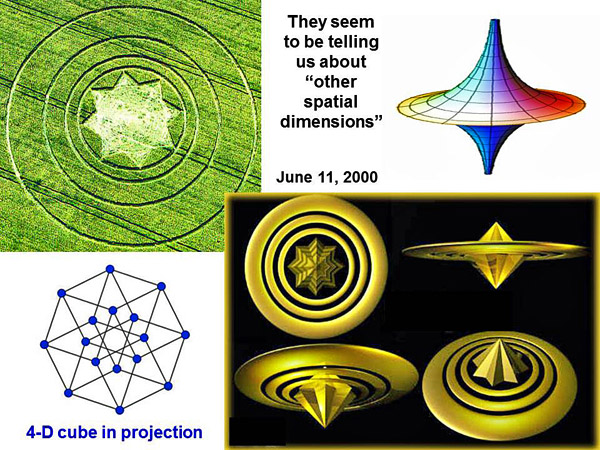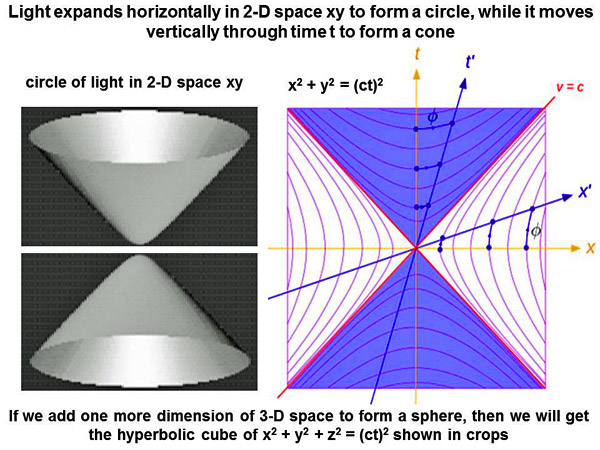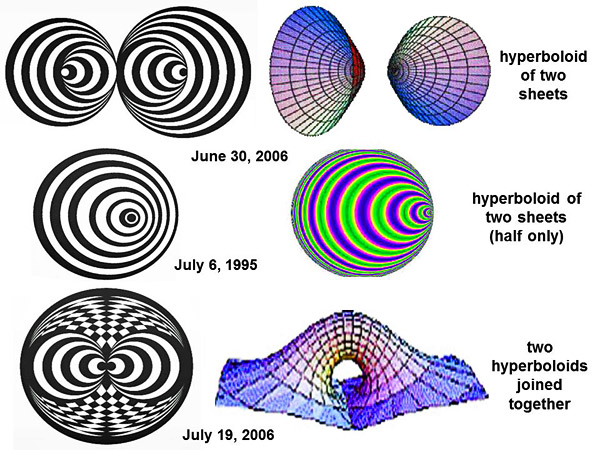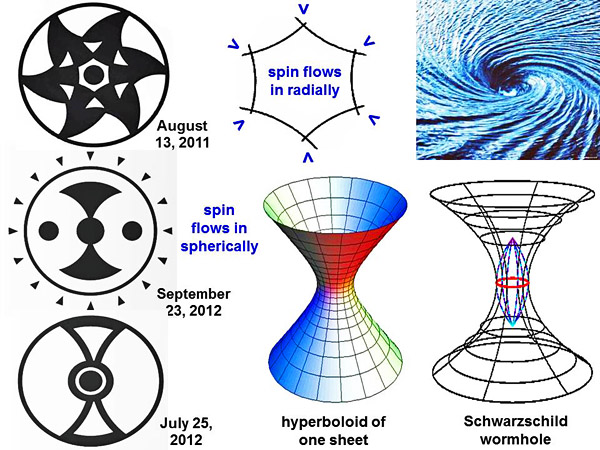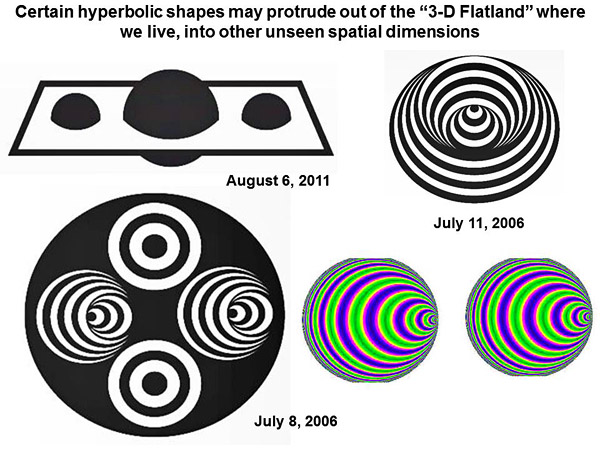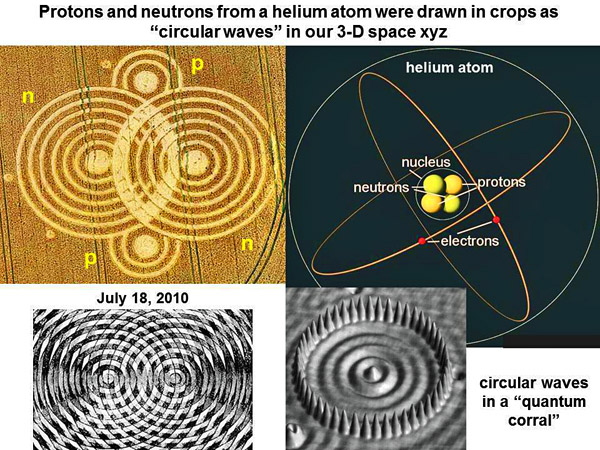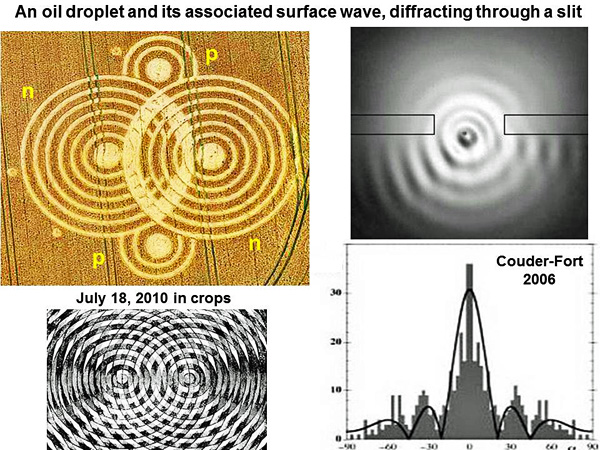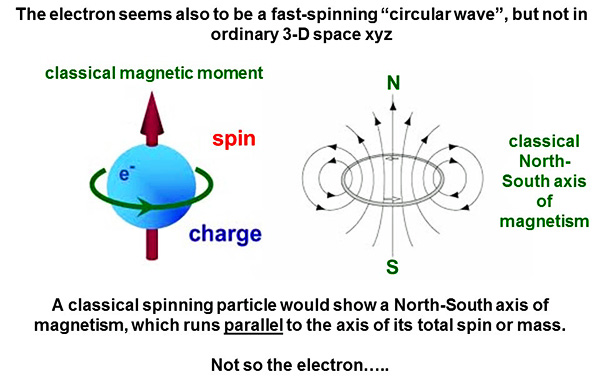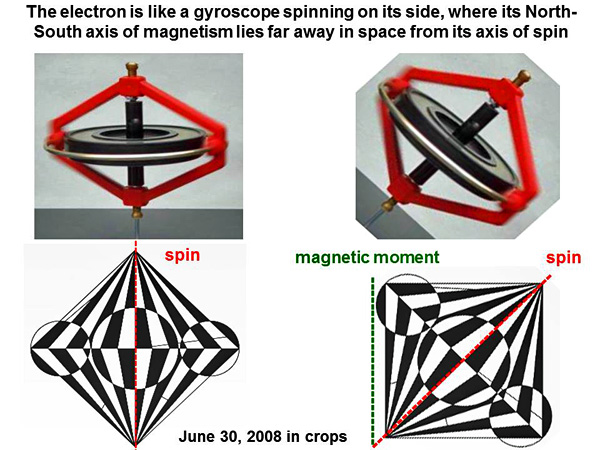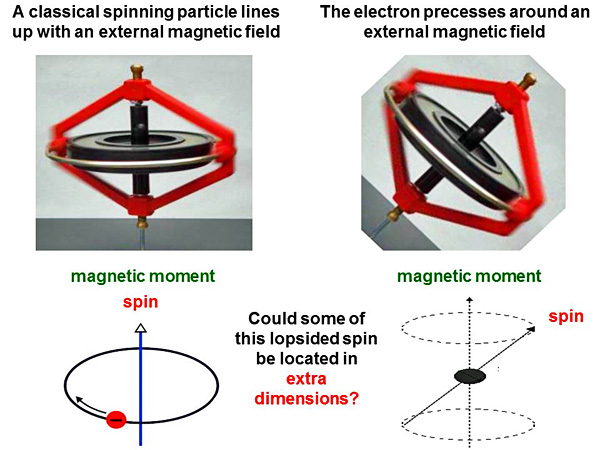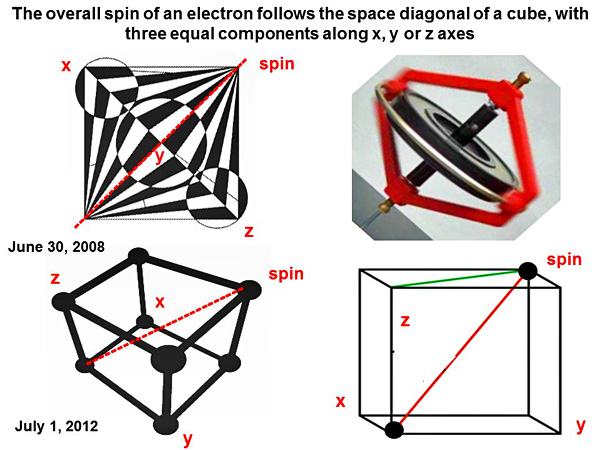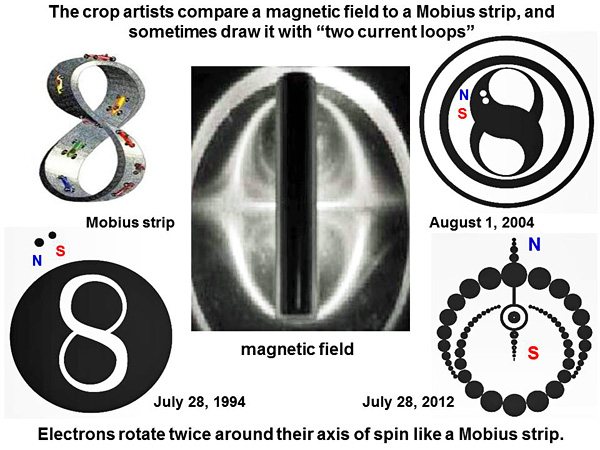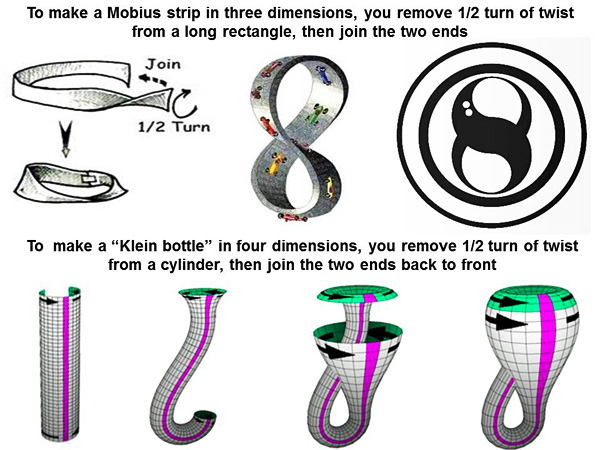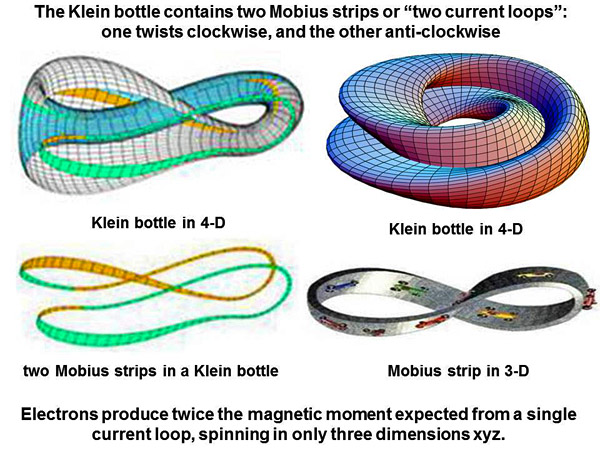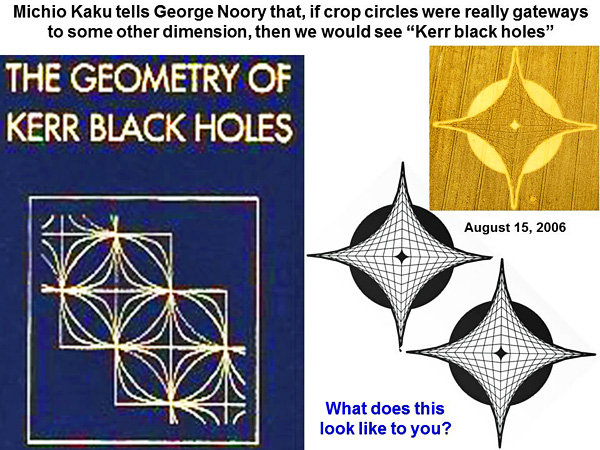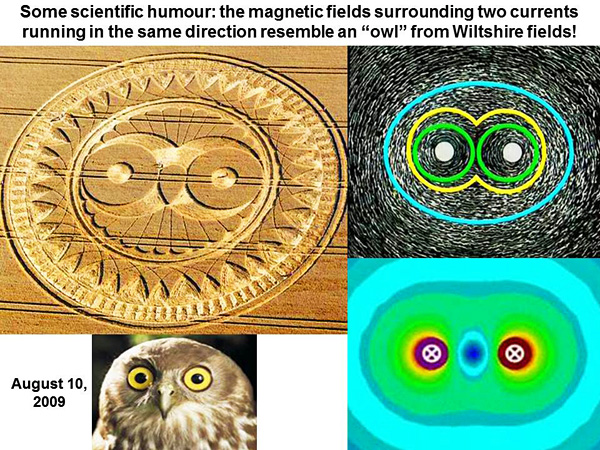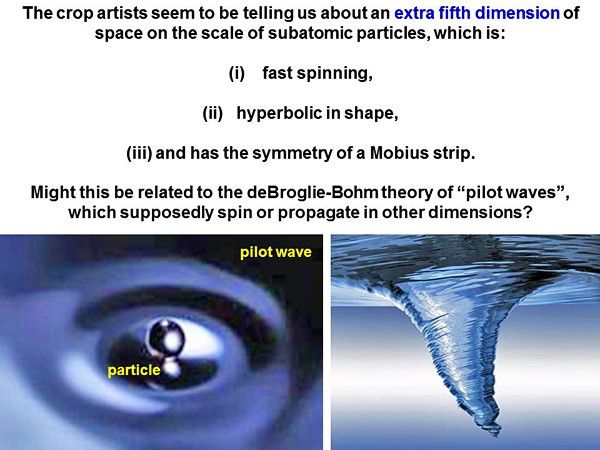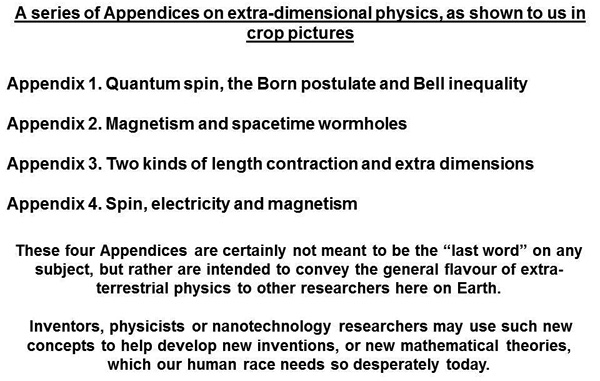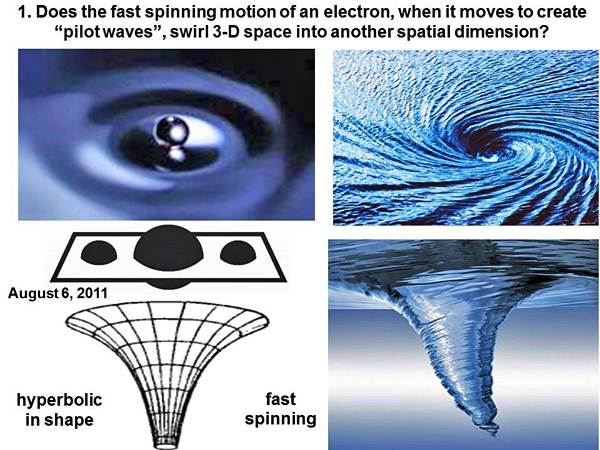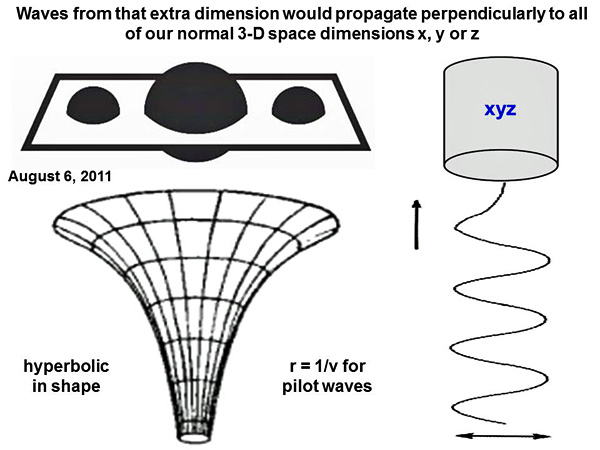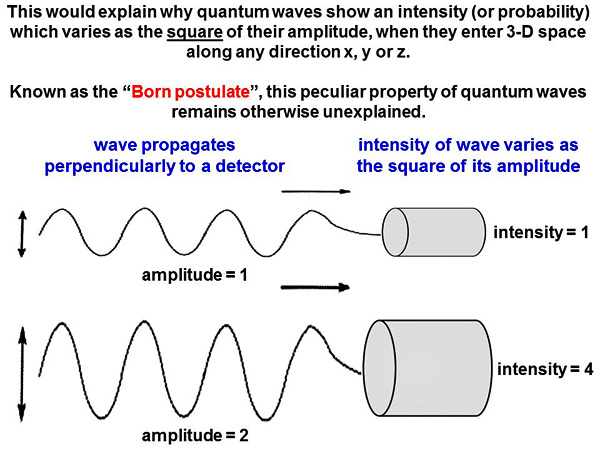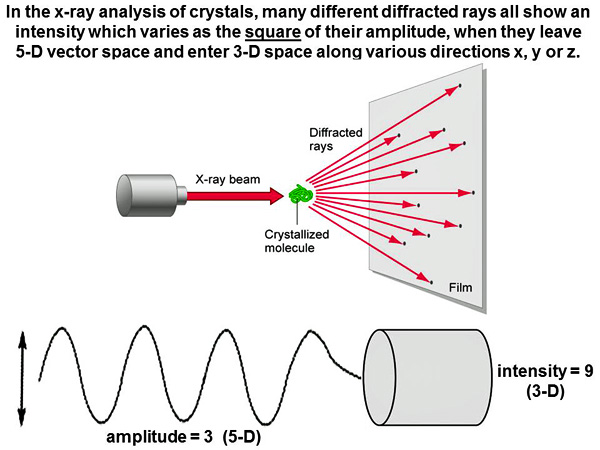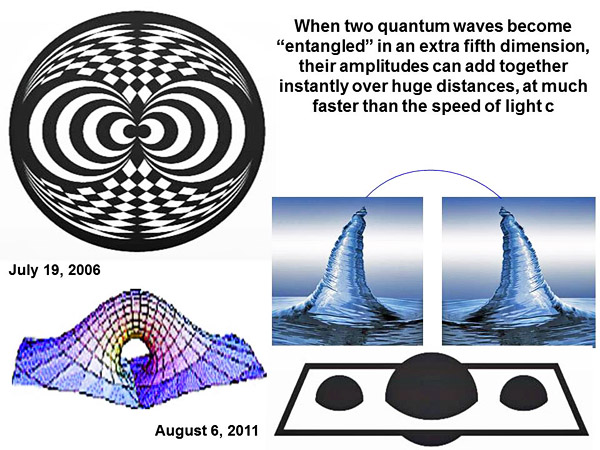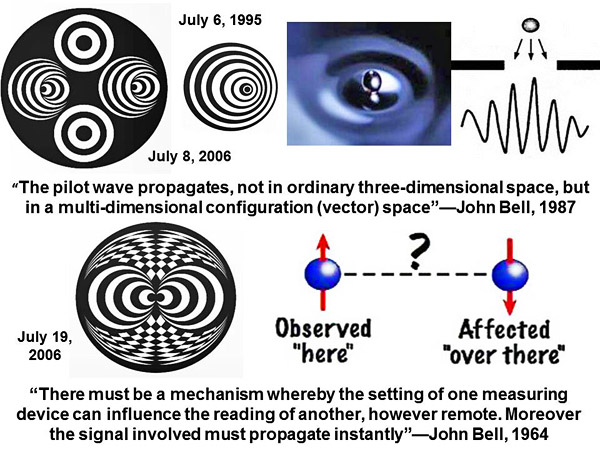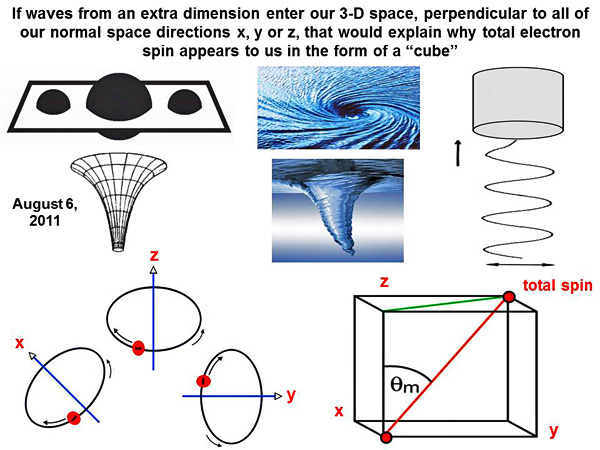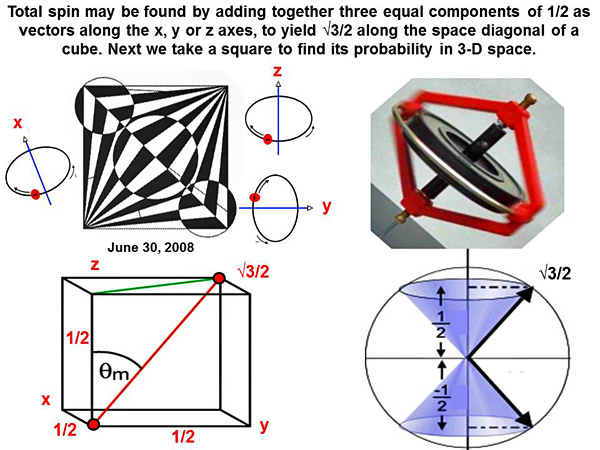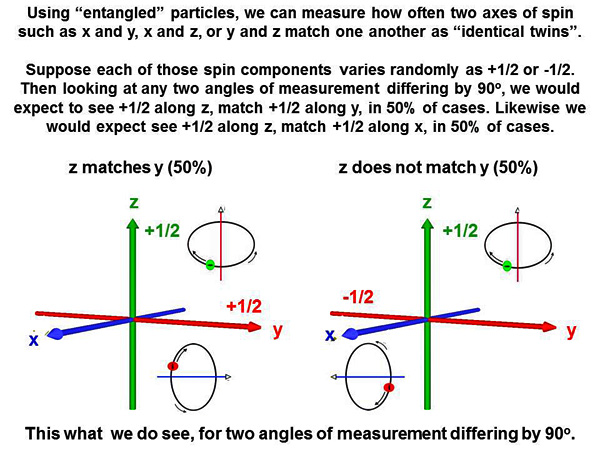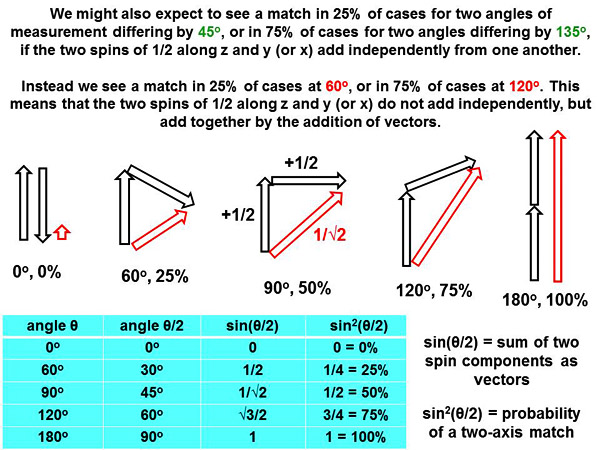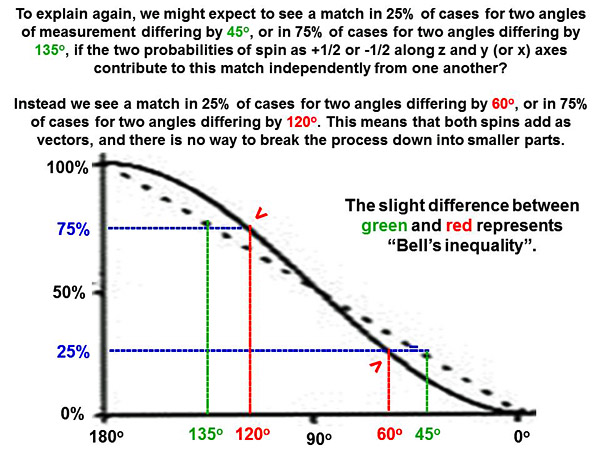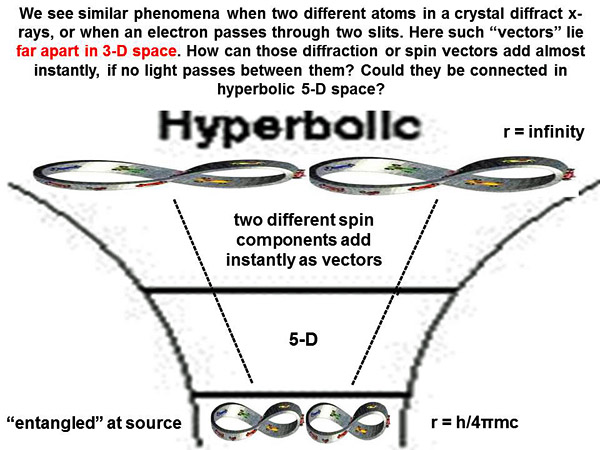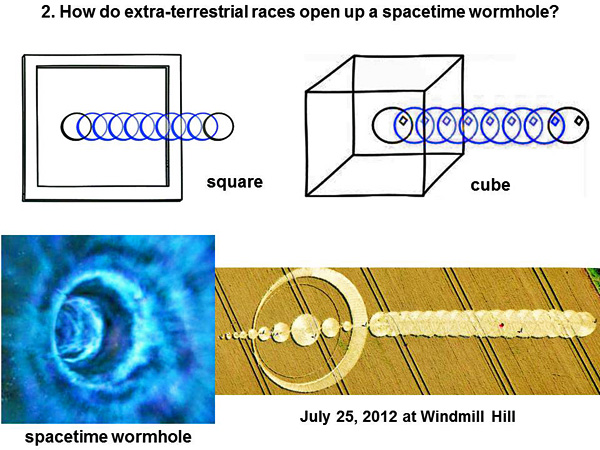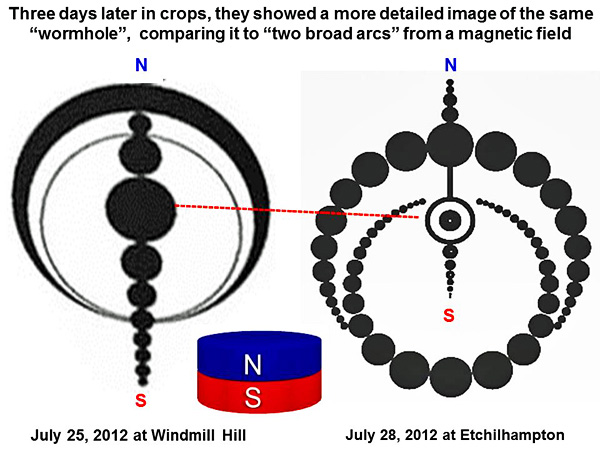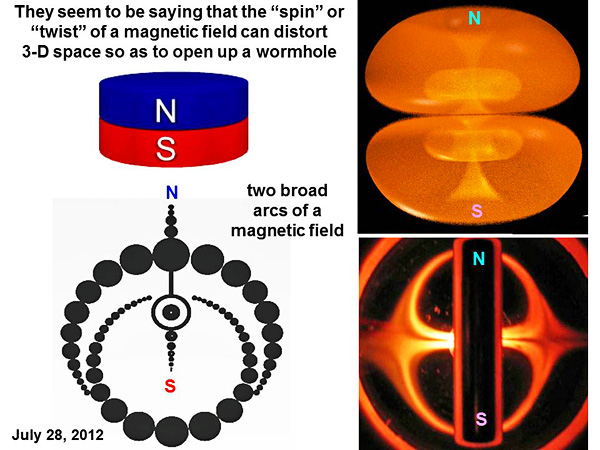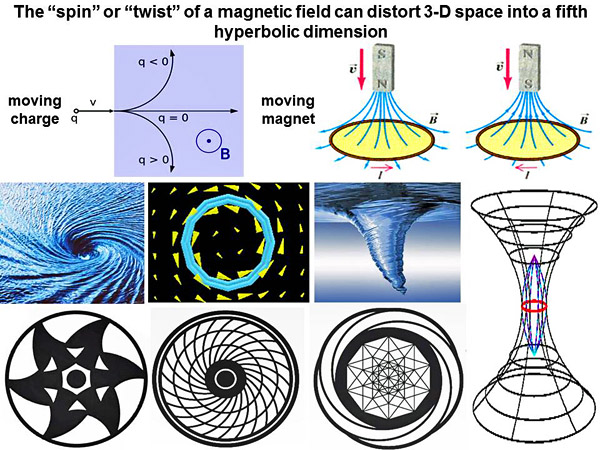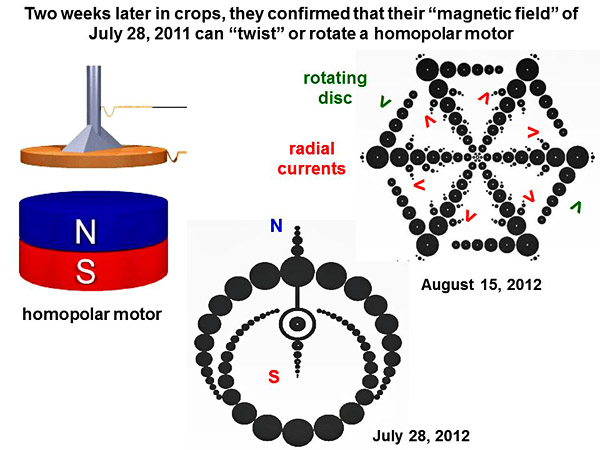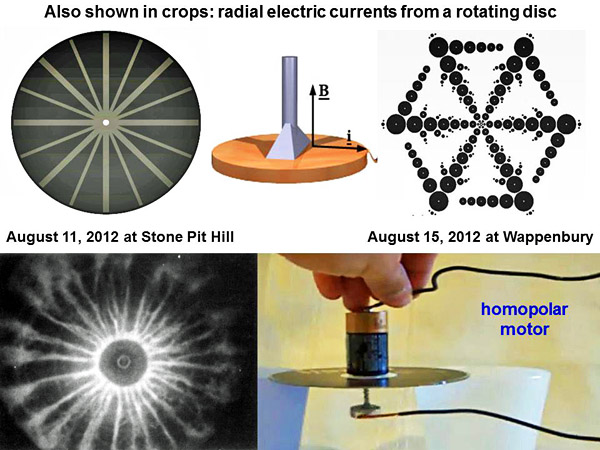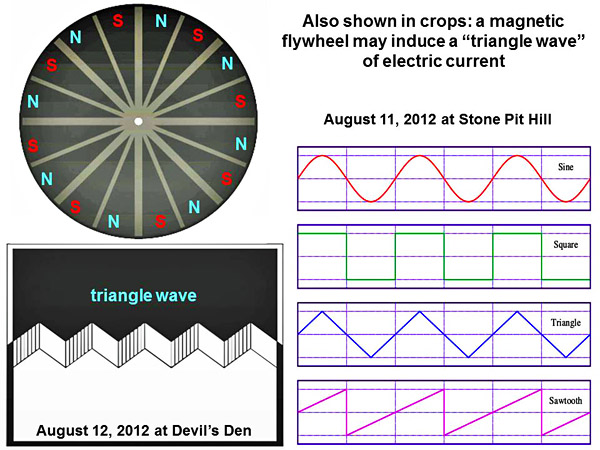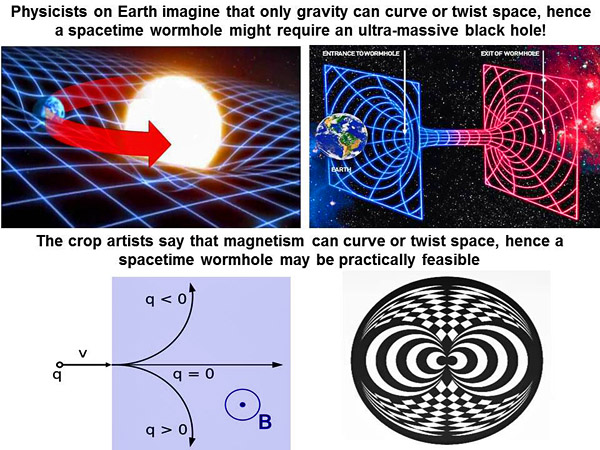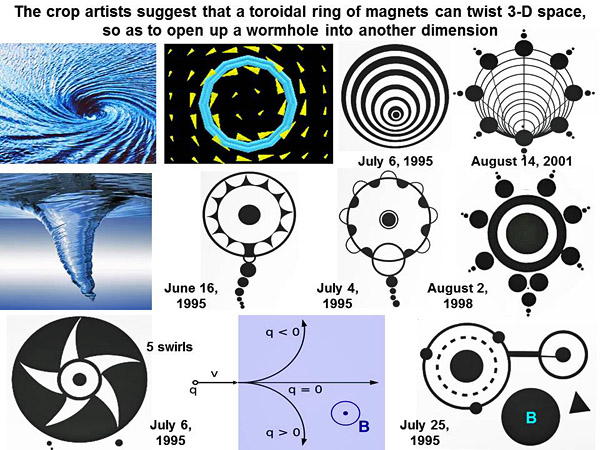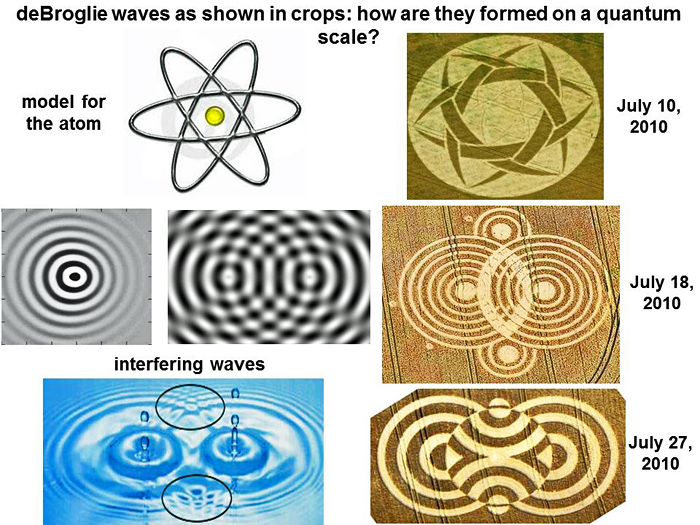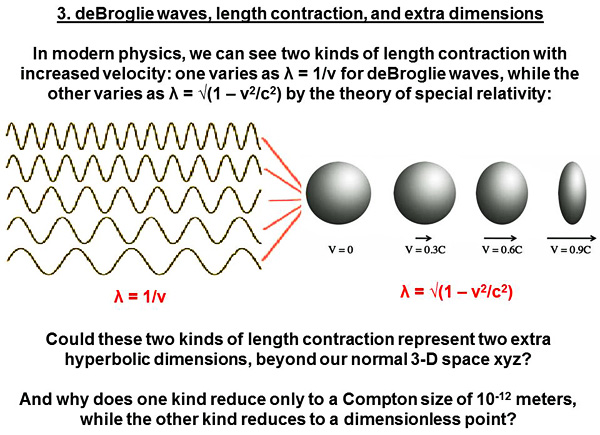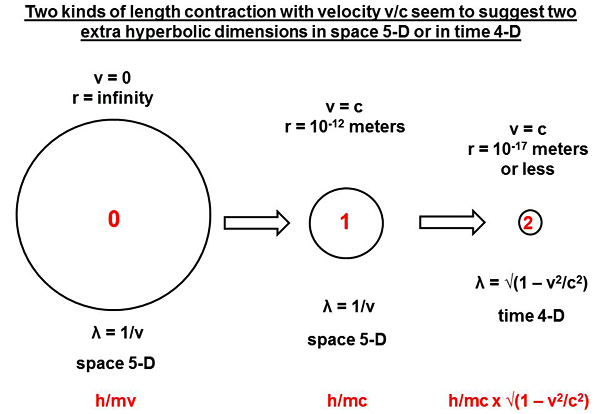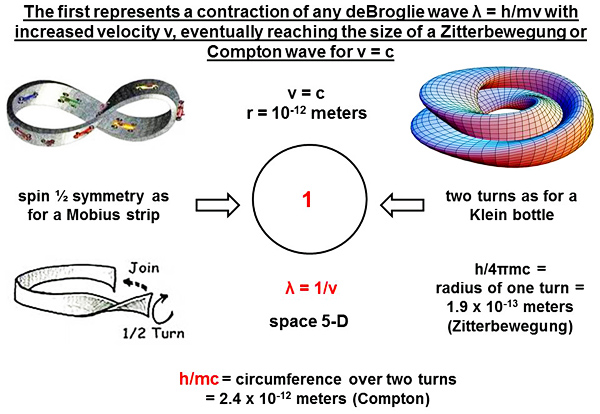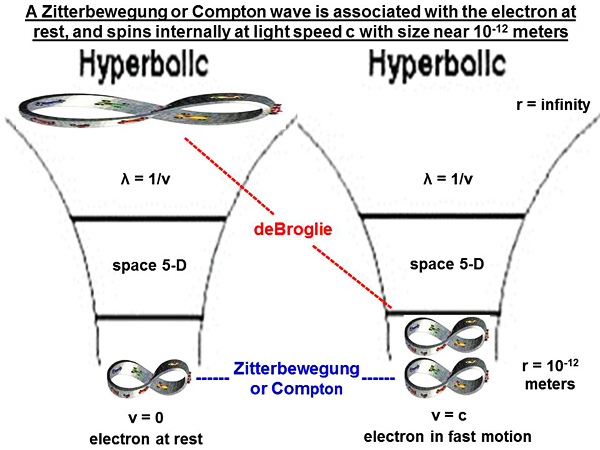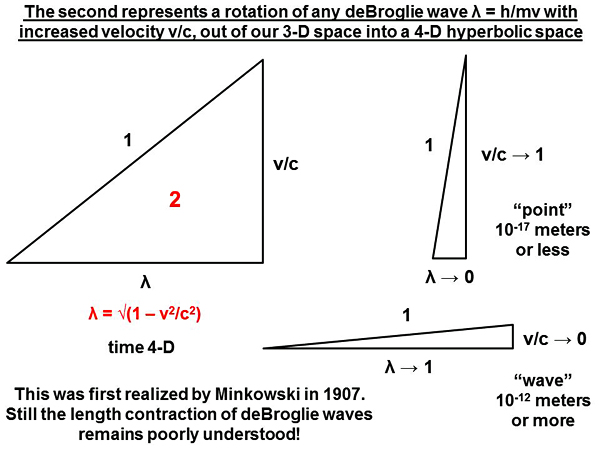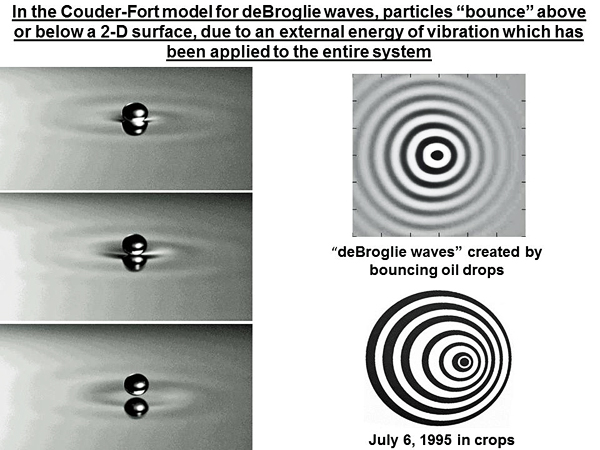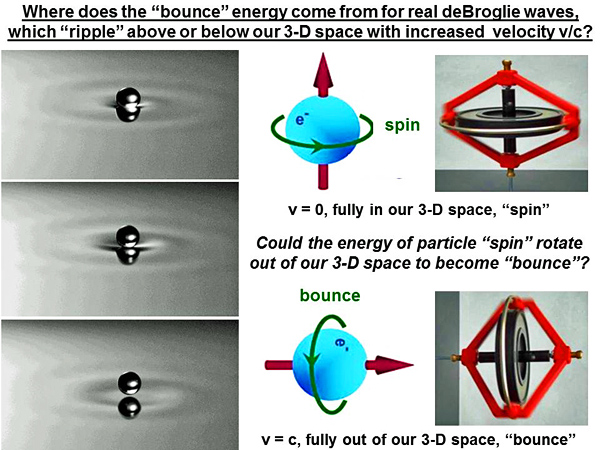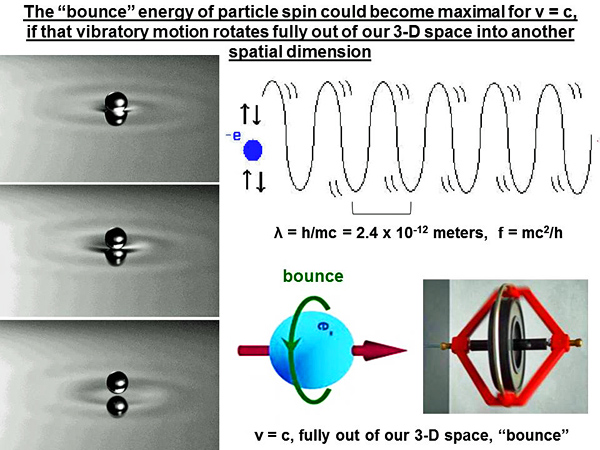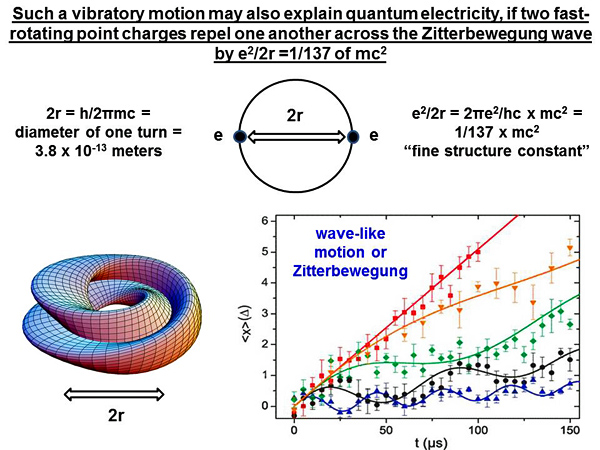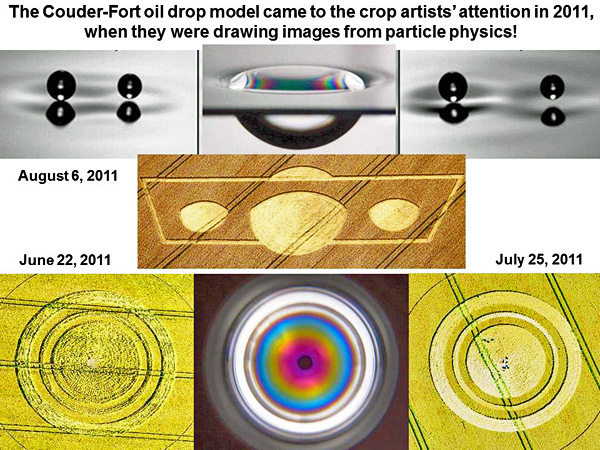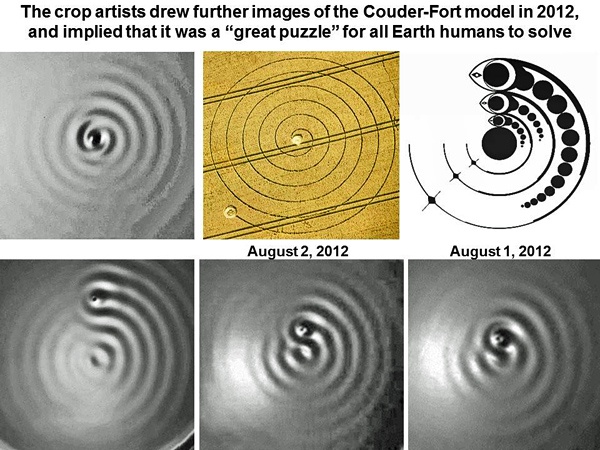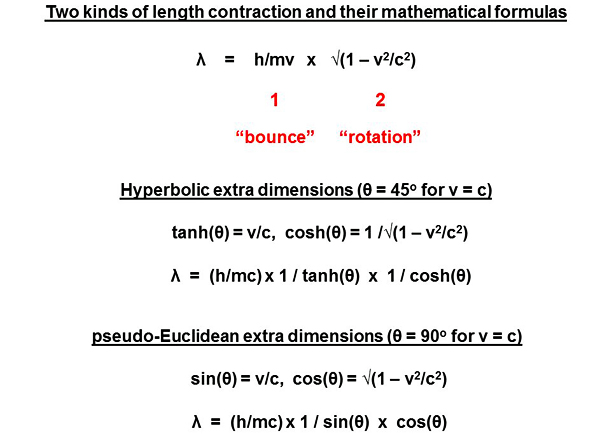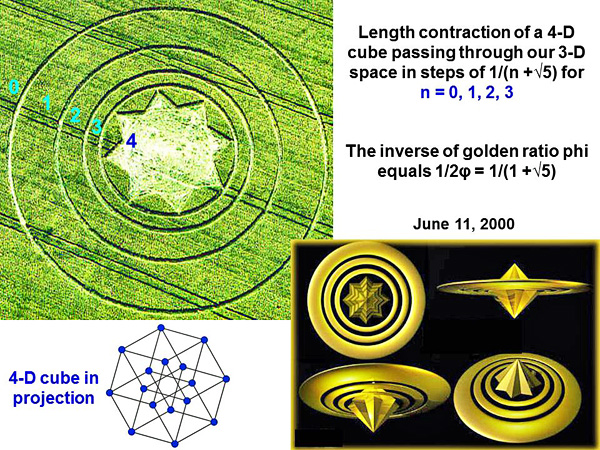|
Part X. Extra-terrestrial physics as shown in crops: could there be another fifth dimension accessible from our three dimensions of space and one of time, which is spinning, hyperbolic, and has the symmetry of a Mobius strip? And could this be the “vector space” of quantum theory? (Every physics student on Earth should learn the information shown in crops about “extra dimensions”: if you are reading this, please forward it to them.) “Other spirits, who see and know the nature and inward constitution of things, how much must they exceed us in knowledge?”---John Locke, Essay on Human Understanding, 1690 Modern crop pictures are one of the most ubiquitous and enduring of paranormal phenomena. They have appeared mysteriously in over 23 countries across the world, most recently in Ohio, Brazil or Australia (see www.earthfiles.com or brazil or Boorowa2012). These strange field images have been appearing on a fairly regular basis since 1990 (see www.cropcirclecenter.com ), although they were known even in Newton’s time (see time2012x or time2012y), and were mentioned in Nature (London) of 1880 (see oldcropcircles.weebly.com/uk-1880-guildford). Two recent reviews on crop circles describe: (i) their photographic or video documentation, (ii) eyewitness observations, (iii) plant morphologies or (iv) intellectual content (see time2012a or time2012b). The consensus view held by most knowledgeable researchers is that crop pictures are being created by other intelligences, who do not normally occupy our current space or time. Whether this means “extra-terrestrials visiting from another star”, or “humans from our distant future (or past)”, or “unknown species from another dimension”, remains not conclusively proven. An unseen fifth dimension of space which is spinning, hyperbolic and has the symmetry of a Mobius strip “That the guide wave propagates, not in ordinary three-dimensional space, but in a multi-dimensional configuration (vector) space, is the origin of non-locality in quantum mechanics. It is a merit of the deBroglie-Bohm version of quantum mechanics to bring this out, so explicitly that it cannot be ignored”---J.S. Bell, 1987 In previous parts of this series, we discussed certain crop pictures which show the “blueprints” for novel electromagnetic motors, or magnetic propulsion systems (see fringe2012h or fringe2012g or fringe2012c or fringe2012a). Here in Part X, we will discuss those crop pictures which relate to extra-dimensional spaces. To be specific, we will present and discuss a long series of crop pictures which are clearly intended to suggest the existence of a fifth spatial dimension, accessible from our own four-dimensional spacetime. The major characteristics of this fifth spatial dimension seem to be that it is: (i) spinning, (ii) hyperbolic, and (iii) has the symmetry of a Mobius strip:
We already know that subatomic particles exhibit a strange intrinsic property called “spin”, which has the symmetry of a Mobius strip. Likewise our fourth dimension of time behaves as if it were hyperbolic in the theory of special relativity (see arxiv.org or Mathematical_transformations#Hyperbolic_geometry). Could this new fifth dimension be the “vector space” of deBroglie-Bohm pilot waves in quantum mechanics? Could it be the vector space of x-ray diffraction, or the faster-than-light space of “entanglement” studies? A new and simple understanding of quantum mechanics in five dimensions In support of this idea, we will suggest (in Appendix 1) that the “Born postulate” takes on a new and lucid meaning in terms of a fifth spatial dimension. There vector addition can take place instantly, at faster than light speed c. When the total vector sum of events (a “sum over histories”) enters our normal 3-D space xyz, its intensity varies as the square of the wave amplitude, since the 5-D wave is propagating perpendicularly (“orthogonal”) to every possible space direction x, y or z. More recently, a faster-than-light character of vector addition from “entanglement” studies has compounded the anomaly: how can all of those spin or diffraction vectors add instantly in ordinary 4-D spacetime, if informational signals in our usual reality cannot propagate at faster than light speed c? Well, if such vector addition does not take place in our usual 4-D spacetime, then there is no real anomaly. This is similar to what quantum physicist J.S. Bell said in 1987 (see John_Stewart_Bell or plato.stanford.edu or /words-of-john-stewart-bell-f-r-s-nobel-prize-nominee). For anyone who understands x-ray diffraction, there is little doubt that Bell’s inequality suggests a faster-than-light character of vector addition in another spatial dimension, and is similar to what x-ray crystallographers have been doing since 1920 (see Appendix 1). The existence of a fifth spatial dimension will come as no surprise to the crop artists, who can apparently access those realms (while we here on Earth live in “3-D Flatland”), or to certain extra-terrestrial races who seem to open wormholes through such an extra dimension, in order to travel rapidly among the stars at much faster than light speed c. We do not use “smoke signals” to send messages around the world, and they do not use chemical rockets to fly through space. Now we will proceed to show a whole series of crop pictures which illustrate the principles of extra-dimensional spaces. Because this article is intended partly for spiritually-minded people who follow “crop circles”, we will not show any deep technical information in the main text, but will defer such technical aspects to Appendices 1-4. Living in 3-D Flatland: all humans on Earth? Quite a few crop pictures have shown the images of 3-D, 4-D or 5-D cubes, while looking down their space diagonals. We have also been shown a schematic image of “Flatland” from Abbott’s famous book of 1884. Are the crop artists trying to tell us that Earth humans live in a 3-D kind of “Flatland”, with other dimensions nearby if we would only look?
Two “cubes” from four or five dimensions are shown below in greater detail:
This interesting crop picture showed the eight-fold cubic projection of a four-dimensional cube, into three-dimensional space:
Two interesting crop pictures from 1999 showed a four-dimensional cube entering our three-dimensional space:
These pictures were based, somewhat amazingly, on a planar fractal known as “Sierpinski’s carpet”:
Another pair of crop pictures from 1999 showed a “sphere leaving a cube”, by “passing through some other dimension”:
This theme was re-visited in 2012 near Windmill Hill, where we saw a “sphere passing through a wormhole”:
Another series of small crop pictures in 2012 seemed to show “passing through a wormhole to reach Earth, from some other dimension”:
Is “physics” something in a textbook, or what we can observe in the real world? We have done our best to choose only those crop pictures for discussion, which do not appear to have been locally human-made. Some of the paranormal crop pictures seem impressive because of their huge size, while others appear impressive because of their complex pattern of fallen plants (the “lay”). As of the date of writing, none of the crop pictures shown here have been “claimed” by any local human artists, who use rope and boards to flatten the crop. Furthermore, one recent crop picture made using rope and boards turned out so badly, that the leading team of human circlemakers had to fake aerial photographs using Photoshop, while they cut the formation out before it could be examined closely on the ground (see www.circularsite.com). One might call this a “control experiment”. Incidentally, what you were told in Physics World from Bristol in 2011 about crop pictures was just a wild, unsupported speculation (see www.iop.org or /crop-circles-explained-with-gps). No one has ever made a single crop picture using portable microwave ovens, so far as any knowledgeable researcher is aware. Some professors nevertheless have argued that “physics” could explain crop circles, if they were somehow being made with portable microwave ovens (see www.youtube.com). What do they mean by the word “physics”? Are they talking about what is written in textbooks? Or are they talking about what we can see in the real world? Apparently they mean the former, rather than the latter. By contrast, here we will be discussing the latter, not the former. A conceptual link to particle physics on a small scale In their search for extra dimensions, many scientists have been looking on a very small scale, because physical objects often show a greater “roughness” (or more dimensions) on a small scale than a large:
In August 2011 we saw the famous “Flatland” crop picture, with an off-centre “spinning spiral” of crop in its largest circle:
One day later we saw the “ATLAS particle detector” at Temple Farm, with a clever code near its centre for a date and time of “August 7, 2011, 0100 hours”:
That code was designed logically in ternary base-3 like for “quark theory”, or graphically as for a “particle event display”. Their “time stamp” was essentially identical to that used at CERN. One week later we saw a “spinning five-dimensional cube”, looking down its space diagonal. The clear implication here would be that subatomic particle spin is in some sense five-dimensional. We also saw in crops, at about the same time, a “spinning 3-D cube” and a small spinning cube in the form of a “hyperbolic hexagon”:
Both 3-D and 5-D cubes showed a series of thin spirals outside, to suggest “spin” and the “number of dimensions”:
Why did they draw a 3-D cube with four thin spirals outside, instead of three?
Simply because this particular 3-D cube (called “Metatron’s”) shows a 4-D cube in projection! Could there be five dimensions on a small scale, if we include three normal dimensions of space xyz, time t and another dimension of “spin”?
Hyperbolic geometry, spin and the fifth dimension Now we will introduce another difficult subject called “hyperbolic geometry”. For any readers who are crop-circle followers, and not keen on advanced geometry, I would advise you just to look at the pictures, although professional physicists may wish to take a deeper interest. Their small spinning cube was drawn in the shape of a hyperbolic hexagon, with three “swirls of spin” nearby along x, y or z:
Why did they draw a small spinning cube with strange “hyperbolic geometry”? In fact, hyperbolic geometry has been shown rather commonly in crops, as if it might be of great importance to the crop artists:
Some crop pictures have even shown a 3-D cube, passing metaphorically from some other hyperbolic dimension, through a “Flatland” type of 2-D plane:
You can see that a small central “triangle” in the crop pictures of July 1 or July 21, 2012 is hyperbolic. This is in fact the deeper meaning of “Metatron’s cube”, which makes one wonder about the ancient origins of sacred geometry. Another series of crop pictures from 2008 showed “Metatron’s cube” inside of a “hyperbolic cube”:
Could fast spinning motion, on a subatomic scale, distort our normal 3-D space into other hyperbolic dimensions? One is certainly encouraged to believe, from all of these crop pictures, that fast spinning motion on a subatomic scale may distort our normal 3-D space into other hyperbolic dimensions:
We seem to live in a kind of “3-D Flatland”, although fast spinning motion may lead us into other dimensions:
The crop artists keep telling us, over and over again, about “other spatial dimensions”:
Hyperbolic geometry and Einstein’s theory of special relativity Soon after Einstein proposed his new theory of special relativity in 1905, Hermann Minkowski gave a “Space and Time” lecture (1907) which related that theory to hyperbolic space (see Space_and_Time):
Light moves horizontally in 2-D space xy to form a circle, while it moves vertically through time t to form a 3-D cone:
If we add one more dimension of 3-D space to expand this picture into 4-D, then we get a hyperbolic cube with six small “clocks” outside, as was drawn in crops on July 18, 2003 (see the previous slide above). Many different images in crops of hyperboloids or spacetime wormholes We have been shown many different images in crops of hyperboloids, either of one sheet or of two sheets:
The hyperboloid resembles in shape a “Schwarzschild wormhole”:
Certain hyperbolic shapes may protrude out of the “3-D Flatland” where we live, into other unseen spatial dimensions:
Circular waves for subatomic particles on a quantum scale On the few occasions where we have been shown subatomic particles in crops, they have been drawn as “circular waves”:
Such circular or triangular waves appear in a scanning tunnelling microscope, if the user creates a closed topology known as a “quantum corral”:
The crop artists evidently see a close relationship between subatomic particles and “Faraday waves” (see www.youtube.com). The deBroglie wave from quantum mechanics, which defines how particles diffract, or how electrons move in atoms, has been compared to a macroscopic Faraday wave (see quantum-mechanics): “An oil droplet can bounce on a surface. Such bouncing causes nearby waves, and those waves propel the droplet along. As oil droplets pass through a slit, they appear at first to be randomly deflected. Yet if you pass them through many times, a diffraction pattern emerges statistically. How might the development of quantum mechanics have been different, if this oil-drop system had been known to its founding fathers?”
The Couder-Fort oil droplet and its associated surface wave look just like what was drawn in crops at Woolaston Grange on July 18, 2010 “According to pilot wave theory, first proposed by deBroglie and later by Bohm, microscopic objects such as photons and electrons consist of both particle and wave, the former being guided by the latter. Although this physical picture has not been widely accepted, it has had some notable proponents including J.S. Bell. Its principal appeal is that it restores realism and determinism to quantum mechanics” (see www.pnas.org). Strange properties of the ordinary electron The electron also appears to be a fast spinning “circular wave” on a subatomic scale, yet has several strange properties:
The electron may be compared to gyroscope spinning on its side, where its North-South axis of magnetism lies far away in space from its axis of total spinning mass:
Thus a classical spinning particle will “line up” with an external magnetic field, whereas the electron can only precess or “wobble” around it:
Could some of this “lopsided spin” for the electron be located in extra dimensions? The overall spin of an electron follows the space diagonal of a cube, with three equal components along x, y or z axes:
Here we see our “crop cube” again, viewed down its space diagonal. Total spin angular momentum for an electron lies 35.3o above the horizontal xy plane, when the magnetic axis is vertical along z. This is also why NMR researchers sometimes use an angle of (90o – 35.3o) = 54.7o away from a vertical axis of external magnetism (see Magic_angle_spinning). The magnetic field and a Mobius strip When the crop artists do show a “magnetic field”, sometimes they compare it to a Mobius strip:
Electrons show a strange property of “spin 1/2 symmetry”, which means that they must rotate twice about some axis to return to the same place with the same “quantum mechanical phase”, analogous to a Mobius strip. The two-lobed image of a magnetic field shown above comes from modern studies using ferrofluids (see nanomagnetics.us), and should supplant older images shown in textbooks, which show only one large lobe. This video discusses two-lobed magnetic fields in relation to extended galactic structures or astronomical jets (see www.youtube.com). To make a Mobius strip in three dimensions, you take a long rectangular ribbon, remove 1/2 turn of twist, then join the two ends:
To make a Klein bottle in four dimensions, you remove 1/2 turn of twist from a long cylinder, then join the two ends back-to-front. The Klein bottle actually contains two Mobius strips or “current loops”. One turns clockwise, while the other turns anti-clockwise (see Klein_bottle):
Electrons produce twice the magnetic moment expected from a single current loop, if it were spinning in only three dimensions. We will return to this difficult subject of “magnetic moment and magnetic fields” in Appendix 4. Magnetic energy may be used to open wormholes: a specific answer to Michio Kaku’s discussion with George Noory Most physicists today imagine that they already know everything there is to know about “magnetism”, by writing down a series of abstract mathematical equations from the 19th century (thanks to J.C.M., see A_Treatise_on_Electricity_and_Magnetism). Yet concerning its deeper mechanism and novel potential uses (such as for clean energy or space propulsion), clearly they don’t know much at all. Only by denying all aspects of paranormal reality as seen occasionally on Earth, for example the UFOs and crop circles, can physicists maintain the illusion of a fully-knowledgeable status quo. Michio Kaku was asked on Coast to Coast radio a few months ago, whether he had found any clues in the crop circles to higher-dimensional physics? (see www.youtube.com) First the host George Noory comments: “Doctor, let me begin by asking you about the crop circle phenomenon. It is intensely interesting. It obviously is more than a couple of guys running around with boards and chains. These crop circles are becoming increasingly complex and increasingly frequent. This is the biggest year yet (2012), and they are absolutely astounding! What is a likely explanation?” Michio Kaku replies, “Well, I have heard some people claim that they are a kind of gateway to another dimension. I’m a scientist. I’m open to all kinds of crazy things. My only statement is that, if you were to build a dimensional gateway, the required energy would be enormous.” George Noory next comments: “If you take certain crop pictures, and draw them on a sheet of cardboard, they seem to bend over into another dimension as they spin. They may be plans (or blueprints) for a propulsion system?” Michio Kaku next replies, “The expected pattern for a dimensional gateway would be a ‘Kerr black hole’, basically a massive spinning ring. A spinning ring could open up a ‘hole’ between our sector of the galaxy and another sector of the galaxy. The key thing is the energy supply. Unless they (the crop artists) tell us the energy source, or the ‘gasoline’ so to speak, (then we can’t build one). You can give for example aborigines the blueprints of a car, but unless you tell them that the car is supplied by gasoline, the car is not going to go anywhere.” Well, Michio and George, the energy source for their spacetime wormhole seems to be some kind of strong magnetism, as explained in Appendix 2 below. Regarding the Kerr black hole, it has been shown several times in crops, sometimes with symbols for the Lorentz force of magnetism nearby:
The image above shows a schematic version of hyperbolic space from Minkowski’s 1907 lecture. And modern Earth humans are clearly not “aborigines”! If the crop artists did not think that some of us had the inherent mental capabilities to understand their technical drawings, and to act on them in a practical sense, then they would not keep showing us the same scientific themes over and over again. Cognitive narrowing, dogmatism, and the refusal to investigate observational or experimental anomalies The general community of physicists on Earth should simply “open their minds” then “lift their game”. It is not that they do not have the required mental capabilities to advance, but they remain too narrow-minded to study technical images from other civilizations more advanced than ourselves. Hundreds or even thousands of regular people have visited Wiltshire (or elsewhere), and have witnessed this paranormal phenomenon convincingly for themselves. Probably two dozen reliable researchers have been studying it for the past 20 years. The irrational rejection of this extensive body of knowledge by learned academics is called “cognitive narrowing” or “dogmatism” (see www.youtube.com or www.psych-it.com.au). As someone well trained in x-ray crystallography at Caltech, and also an expert on the structure of DNA, plus some aspects of molecular biology (see wormholetechnology), I do not pretend to be an expert at magnetic or subatomic physics. It is really up to leading physicists on Earth to study carefully the technical drawings which we have assembled here in one convenient place (as well as in previous parts of the series), and to use such knowledge productively to create new theories or new inventions. The crop artists show great knowledge of biology and chemistry as well Those paranormal visitors drew the “nucleosome core of chromatin” in crops on August 28, 2002, just before we held a high-level meeting in Cambridge on the same subject (see the link above or www.zefdamen.nl). Furthermore, it was laid down in the general direction of Cambridge from Avebury. I worked in a lab at Cambridge for five years, where an x-ray crystal structure of the “nucleosome core” was first analysed (after crystals were obtained by L. Lutter and D. Rhodes, following a suggestion by Francis Crick). Later I found there the 10.2 helical periodicity of DNA in chromatin, which resolved something called the “linking number paradox”, because DNA in solution has a helical periodicity of 10.6. Also I found that the base sequence of DNA influences how it wraps tightly in the nucleosome core, as a Fourier transform of certain base-stacking potentials over 120-145 base pairs. The crop artists seem to know advanced science of all kinds, ranging from chemistry to biology and astronomy, math or physics. It is in physics where their field diagrams seem to diverge most, from our currently accepted knowledge here on Earth. Two biochemical molecules shown recently in crops were melatonin (with a “pineal gland” drawn nearby on the next day) or vitamin A (which is a dimer of the beta-carotene found in red poppies (see time2012b or 4mileclump or www.youtube.com/watch?v=1qxtV6gTWrw). Are you “afraid of aliens”, even though all you know about them comes from Hollywood movies or TV shows? Some people say that extra-terrestrials are terrifying, so we should avoid contact with them at all costs. This is what Stephen Hawking advised everyone on a TV show “Fear the Aliens” (see stephen-hawkings-universe-fear-the-aliens). Could that really be true, or is it just more disinformation? The crop artists often use subtle humour in their field pictures, typically of a “Big Bang, Sheldon Cooper” variety. Shown below for example is the image of an “owl” in crops from 2009, which also represents a distinctive pattern of magnetic fields, surrounding two electric currents that run in the same direction:
Personally I find this crop picture to be very funny! Some e.t. visitor was reading a book on magnetism, while also studying Earth wildlife such as the Wiltshire owls. He or she thought, “The combination of those two ideas would make a great theme for a crop picture!” Somehow I do not think that the extra-terrestrial crop artist, who designed and made this clever field drawing, would be “scary” or “dangerous”. Perhaps someone to trade jokes with Kaley Cuoco? Other interesting links Here is an interesting video about the Klein bottle in four or five dimensions (see www.youtube.com times 37:00 to 39:30). Here is an interesting article about hyperbolic space on a large scale in astronomy (see expanduniverse). Here is an interesting description of how crop circles may be reconstructed in three dimensions, then spun to search for a deeper meaning (see adgift). “Is there a fifth dimension?” (see www.youtube.com) Summary and conclusions for the casual reader: an extra fifth dimension of space In summary, the crop artists seem to be telling us, over and over again, about an extra fifth dimension of space, at least on the scale of subatomic particles, which is (i) fast spinning, (ii) hyperbolic in shape, and (iii) has the symmetry of Mobius strip:
When I studied modern physics carefully, in order to understand how their paranormal images (perhaps sent from another dimension) might relate to what we already know here on Earth, I found the deBroglie-Bohm theory of “pilot waves”, which supposedly spin or propagate in other dimensions. A possible fifth dimension of space was first proposed in 1925 by Kaluza and Klein, while they were trying to unify theories of gravity and electromagnetism (see Klein_theory). That theory has been discussed broadly in terms of particle spin (see intrinsic-spin or /revised-paper-on-kaluza-klein-and-intrinsic-spin-based-on-spatial-isotropy or tandfonline.com). Theirs was a tiny “loop of space” near size 10-35 meters. Here we are talking about much larger distortions of space in the shape of hyperboloids, which might be expanded into spacetime wormholes for propulsion, or fast travel among the stars. Obviously we can’t just show “pretty pictures” to modern academic physicists, and expect them to change their minds about subjects which they studied for years in school. For that reason, we will continue with four technically difficult Appendices below. Red Collie (Dr. Horace R. Drew, Caltech 1976-81, MRC LMB Cambridge 1982-86, CSIRO Australia 1987-2010) P.S. Many thanks to all of the crop circle researchers or photographers who have made this work possible, with very little credit or benefit to themselves over the past 20 years. We are indebted also to Michael Reed (an astrophysicist) for his insights as to what modern crop circles mean. Mike passed away unexpectedly last summer, but he is certainly not forgotten.
Appendix 1. Quantum spin, the Born postulate and Bell inequality Does the fast spinning motion of an electron, when it moves to create “pilot waves”, swirl 3-D space into another spatial dimension?
Waves from that extra dimension would propagate perpendicularly to all of our normal 3-D space dimensions x, y or z:
This would explain why quantum waves show an intensity (or probability) which varies as the square of their amplitude, when they enter 3-D space along any direction x, y or z. Known as the “Born postulate” of quantum mechanics, this peculiar property of quantum waves remains otherwise not understood:
Suppose for example that a quantum wave propagated along the z axis in 3-D space? Then we would see it perpendicular to both the x and y directions. Its intensity in the xy plane would vary as the square of its wave amplitude along z, like for a flashlight shining down on a table (see probabilities). Instead, we see that quantum waves show intensities which vary as the square of their wave amplitudes for every possible direction in 3-D space xyz. How could this be, unless the quantum wave propagates in a dimension which is perpendicular to all possible directions in our normal 3-D space? Born described “squaring of the amplitude” in terms of water waves propagating along a flat 2-D surface: “In the same way that a water wave produced by an ocean steamer causes secondary circular waves, when it strikes a wooden piling, so an incident electron wave may be partly transformed into a secondary spherical wave. The square of the amplitude of that secondary wave determines its probability of scattering” (see www.nobelprize.org). If we go from Born’s 2-D water analogy to our regular 3-D space, then we can easily imagine that oscillations of 3-D space in another unseen dimension, “above or below the plane of the water surface” so to speak, may be responsible for quantum wave behaviour as observed in the real world. These oscillations could be of several different kinds, and remain to be defined mathematically. Every x-ray diffraction experiment performed on Earth since 1910 or 1920 would follow the same extra-dimensional mechanism:
X-ray diffraction workers first calculate a total wave amplitude, by adding up vectors of scattering from each individual atom. Next they take the square of that vector sum, in order to say how many x-ray photons will be counted along any “Bragg scattering plane hkl”. They have no physical basis or explanation for doing so. The mathematical procedure just “works”. Entanglement studies: the “diffracting system” gets much bigger Now in modern “entanglement” studies, two quantum waves may add as vectors over some huge distance in 3-D space xyz, much larger than the confines of a single crystal:
The process of adding vectors to reach a total sum happens almost instantly, at much faster than light speed c. The simplest explanation, as J.S. Bell once noted, would be that vector addition does not take place in our normal 4-D spacetime xyzt:
If such quantum waves enter our 3-D space from another spatial dimension, this would also explain why total electron spin appears to us in the form of a “cube”:
We would expect to see three equal components of electron spin along x, y and z (forming a cube). Next we would take a square of the cube-like vector sum, to find a probability of observing some total spin in 3-D space:
These next few slides concern the “Bell inequality”, and may be too difficult for a casual reader. We can only measure “total spin” and “spin along z” from a single particle, leaving the values of “spin along x” or “spin along y” unknown. It seems obvious that if three different spin components along x, y or z are linked in some extra dimension, then measuring one component might disturb the two others. Yet if we make two “entangled” particles, something like for “identical twins”, then we can measure “spin along z” in one particle, plus “spin along x” or “spin along y” in its identical twin. We are able to see then, for any two angles of measurement differing by 90o, that spin along z as +1/2 or -1/2 matches spin along x (or y) half of the time, just as one might expect naively from simple probabilities:
Now let us make a similar set of measurements for two general angles differing by 0o to 180o. What do we see? Naively we might expect a 25% match between spins along z and x (or y) for measuring angles differing by 45o, along with a 75% match between spins along z and x (or y) for measuring angles differing 135o. Instead we see a 25% match for two angles of measurement differing by 60o, or a 75% match for two angles of measurement differing by 120o:
One can show mathematically that this is because the two spins along z and x (or y) do not add together independently, like for flipping two coins, but rather add together as vectors like for head-to-tail arrows (see the red arrows above). After taking any vector sum, next we take the square of its length (amplitude) to find a probability (intensity) for two joint values of spin in our 3-D space (see “Bell’s inequality and quantum correlations” by D. Harrison, American Journal of Physics 50, 9, 811, 1982 /Harrison-Bell-Inequalities). Below we show the same mathematical formula in terms of a graph with pretty colours. Now you understand “quantum physics”! If the two spins added independently from one another (like for flipping two coins), we would see the green lines. Instead those two spins add jointly as vectors, giving us the red lines:
As explained above, this works by a similar principle to all x-ray or electron diffraction experiments, which are time-tried and well-studied. Its only plausible mechanism would be an instant addition of far-away vectors in some hyperbolic, extra fifth dimension, where light speed c is not relevant:
In summary, the evidential case for an “extra fifth dimension” seems strong, although further experiments and theories certainly need to be carried out or developed. This is part of what the crop artists have been trying to teach us. After we fully understand the consequences of a fifth spatial dimension for physics, then we may conceive of new ways to produce clean energy or magnetic space propulsion. Appendix 2. Magnetism and spacetime wormholes How do the advanced extra-terrestrial races travel to Earth, and how do they open up spacetime wormholes? We saw an illustrative drawing in crops at Windmill Hill on July 25, 2012:
Three days later, they showed a more detailed image of the same “wormhole”, comparing it to “two broad arcs” from a magnetic field:
They seem to be saying that the “spin” or “twist” of a magnetic field can distort 3-D space, so as to open up a wormhole:
Can the spin or twist of a magnetic field distort 3-D space into another hyperbolic dimension?
Two weeks later in crops, they confirmed that their “magnetic field” (the same one used to open up a wormhole) can twist or rotate a homopolar motor:
Also shown in crops were radial electric currents from a rotating disc:
As a clever double meaning, they next suggested that a magnetic flywheel may induce a “triangle wave” of electric current:
Physicists on Earth imagine that only gravity can curve or twist space, hence a spacetime wormhole might require an ultra-massive black hole:
Instead, the crop artists seem to be telling us that magnetism can curve or twist space. Hence a spacetime wormhole might be technically feasible on an Earthly scale. Indeed, the crop artists have suggested to us, over and over again, that a toroidal ring of magnets can twist 3-D space, so as to open up a wormhole into another dimension:
Here is a second general conclusion which may be “taken home” from crop circle studies. Just as for the existence of a “fifth spatial dimension”, we may add that “magnetic energies can open up small spacetime wormholes”. The process does not seem to require large, ultra-massive black holes. Small wormholes have been seen or photographed over some crop pictures, while they leave a strong magnetic trace in the field, that can disrupt electronic cameras or mobile phones. Unexplained loud booms or light flashes across the USA in January 2013 (or earlier) As I write this, a new series of unexplained loud booms or light flashes have been heard or seen in various locations across the USA (see www.earthfiles.com ). One was even caught on video (see mystery-explosion-caught-on-video-video). A similar event was noted in Alaska just before a recent 7.5 earthquake. Likewise before a major crop picture appeared in East Field on July 7, 2007, a flash of “sheet lightning” was seen and recorded on multiple video cameras by Winston Keech. Perhaps that light-flash marked when a small robotic device from some other dimension entered our 3-D space? (see the_crop_circle_mystery or esp_circuloscultivos23) One might call both kinds of incident “Fringe events”, after a popular TV series which has educated the public on such matters: see FRINGE TV SERIES. Appendix 3. deBroglie waves, length contraction and extra dimensions “I don’t want to believe that creatures with breathtaking knowledge are here, but choosing to interact with us only indirectly.” “A two-dimensional being cannot look up, for then it would see into the third dimension, which is impossible for it to do. What would it see as a 3-D ball passes through the 2-D plane where it lives? First it would see a dot that grows into a line. Then it would watch that line slowly contract again into a dot, before it disappears. A two-dimensional being might never understand the true nature of a 3-D ball, because its two-dimensional mind cannot easily grasp the concept.”---Whitley Streiber, The Key, 2011 In the main text and Appendices 1-2 for Part X, we discussed evidence for a fifth extra spatial dimension as shown in crops. It would accompany our usual three dimensions of space x, y, z and one dimension of time t. We showed many different crop pictures from the years 1994 to 2012 which support that idea, and we introduced two new and important concepts about “extra dimensions” into Earth physics. The first new concept was that “vector addition” from quantum mechanics seems to take place in another spatial dimension, which is not limited to light speed c. When the total amplitude of such a wave enters our 3-D space, perpendicular to all possible directions x, y or z, its apparent intensity (or probability) varies consequently as the amplitude squared. That is the Born postulate of quantum mechanics, which was not previously understood. The second new concept was that magnetism, in previously unknown forms, is apparently being used by many extra-terrestrial races to generate clean energy, to travel through space, or even to open up spacetime wormholes. Possible details of this second concept will be discussed in Appendix 4. Here in Appendix 3, we will introduce a third new concept into Earth physics: namely how an extra-dimensional character can help to explain the wave-particle duality of quantum mechanics. Certain images from the Couder-Fort experiments in Paris, which have provided much new insight into wave-particle duality, were drawn in crops during the summers of 2011 and 2012. Likewise a whole series of “quantum waves” were drawn in crops during the summer of 2010, just before the Fukushima nuclear disaster. Quantum waves as drawn in crops During the summer of 2010, a whole series of “quantum waves” were drawn in crops, perhaps as a prelude to the nuclear power disaster at Fukushima in March 2011 (see japantsunami2011). For example on July 10, 2010 we saw a “planetary model for the atom”, with an interesting overlay of the same image inside:
Then on July 18 and 27, 2010, we saw several sets of “interfering waves”. Those crop-based images appear practically identical to the new particle-wave associations being studied on a macroscopic scale in silicone oil by Couder, Fort and their colleagues in Paris (see phys.org). How might such unusual particle-wave associations, first proposed by deBroglie in 1925 (see broglie-lecture), be formed on a quantum scale? Two different kinds of length contraction in modern physics: what could this mean? Before addressing that problem directly, we need to supply the reader with a bit of background information. Since 1930 we have known that particles or waves may “contract in length” with increased velocity v by two separate mechanisms. First we can see that quantum or deBroglie waves will reduce in length by λ = 1/v, where λ is their wavelength and v is their group velocity:
Next we can see that particles or waves will also reduce in length by λ = √(1 – v2/c2) according to Einstein’s theory of special relativity. Could these two kinds of length contraction involve motion through extra dimensions of space or time, beyond our normal 3-D space xyz? Both mathematical formulas resemble hyperbolic functions such as y = 1/x or y = √(1 – x2). We can also see a striking anomaly which is not explained anywhere in physics textbooks. Thus the first kind of length contraction for deBroglie waves as λ = h/mv reaches a lower limit of h/mc or 10-12 meters for velocity v = c. That is the “Compton wavelength”, where an electron at rest scatters x-rays like billiard balls. There must be some deep relation between deBroglie h/mv and Compton h/mc waves, but of what kind? As a further anomaly, we can see that the second kind of length contraction goes all the way down from 10-12 meters to a “dimensionless point” of size 10-17 meters or less. It must be very different from the first kind of length contraction in some unexplained way. Feynman once wrote that you do not have to go very far into biology, to find some deep phenomenon such as cell motility or cell development which nobody has the answer to. Now I will say the same about physics: you do not have to go very far into modern physics, before you find conceptual holes that you could drive a truck through! Because these relations are so important, we will state them again in a slightly different way:
Two kinds of length contraction with velocity v/c seem to suggest two extra dimensions in space 5-D or time 4-D, which might have a hyperbolic character in terms of their geometrical structures and/or mathematical formalisms. These are well-verified facts. For example when a fast-moving electron diffracts in a microscope (see Electron_diffraction), its deBroglie wavelength at 0.7c becomes only 71% of that expected from λ = h/mv, due to a second kind of length contraction by √(1 – v2/c2). At even higher velocities of 0.9999c or more, its deBroglie wavelength may go down to 10-17 meters or less, due to both kinds of length contraction combined (see Electron). Further details for the first kind of length contraction
If you are a non-technical reader, please bear
with me for a few more slides! We need to
introduce several more concepts, before you can
understand the latest experiments in quantum
physics, or what those paranormal crop artists
have been drawing in the fields.
Any deBroglie wave has the symmetry of a Mobius strip, and may show two radial turns as for a Klein bottle (projected from four into three dimensions). Also for the upper limit of v = c, a deBroglie wave λ = h/mv will reduce in size to h/mc = 2.4 x 10-12 meters, which is the Compton wavelength of an electron at rest. The radius of each turn may be calculated easily as h/4πmc =1.9 x 10-13 meters. This is called the “Zitterbewegung” radius, which is a German word meaning “trembling” or vibratory. A Zitterbewegung or Compton wave is associated with the electron at rest, as well as with any electron in rapid motion. It is thought to rotate or “spin” at light speed c with size near 10-12 meters:
Now the deBroglie wave is associated only with an electron in motion, not an electron at rest. It shows a wavelength of infinity for the electron at rest, then reduces in size to a Zitterbewegung or Compton value for an electron moving at speed v = c. Such strange behaviour! What could it mean? Additional references to spin, Zitterbewegung or electron size have been added to the end of this Appendix below. Further details for the second kind of length contraction The second kind of length contraction seems more well understood. In 1907, Minkowski (who was Einstein’s teacher at ETH) gave a famous lecture on “Space and Time” in Gottingen (see Space_and_Time). There he explained how that second kind of length contraction could be represented mathematically by an angle of rotation in four-dimensional hyperbolic space:
To help understand this strange concept, first let us imagine a “ruler”. The ruler remains of normal length while it is fully present in our usual 3-D space, for velocity v = 0. Yet when that ruler begins to move with a velocity v which approaches an upper limit of c, it literally “rotates out of” our 3-D space into a fourth hyperbolic dimension of time. Thus at high speeds of v near c, we can only see the ruler “end on” as a foreshortened projection, and therefore it appears much “shorter” than before. Einstein proposed the second kind of length contraction in 1905, so Minkowski had two years to study that problem carefully before coming up with his amazing hyperbolic geometry, which unites 3-D space with 4-D spacetime. Twenty years later in 1925, deBroglie proposed yet another kind of length contraction (which we call the “first”), and the subject was thrown into a deep confusion from which has still not recovered to this day. The Couder-Fort oil-drop model for deBroglie waves Having explained all of the necessary concepts, now we can get onto the real substance of this article! Until recently, no one had a clue as to what deBroglie waves might represent physically, or why they contract by λ = h/mv to h/mc as v goes to c. Then a group of scientists in Paris (led by Yves Couder) who were studying fluid mechanics, assisted by mathematician John Bush at MIT, stumbled onto a new, macroscopic model for deBroglie waves which has provided much physical insight (see www.youtube.com or www.youtube.com or www.pnas.org). Their most recent discovery concerns the Zeeman effect, and was published on July 9, 2012 (see bouncing-droplets-simulate-zeeman-effect). As we shall see below, some of the crop artists apparently read their most recent work, then designed and constructed two very clever crop pictures in early August of 2012, which seem to have quite specific symbolic connotations. The crop artists also made two simpler crop pictures in 2011, possibly to illustrate an earlier Couder-Fort model of less complexity. What do Couder, Bush and Fort have to say about deBroglie waves? In the Couder-Fort model, particles (as oil droplets) “bounce” above or below a 2-D surface made of silicone oil, due to an external energy of vibration which has been applied to the entire system:
That “bouncing” motion then creates a series of “circular waves”, which extend stably on all sides of the bouncing “particle” (or oil droplet). These circular waves seem closely akin to a crop picture which was drawn at Cissbury Rings on July 6, 1995, or several others. What is the “bounce” energy in real quantum systems? There is no (or little) external energy of vibration for real deBroglie waves in quantum systems. We can be sure of this, because the deBroglie wavelength goes to infinity (zero energy) for an electron at rest or v = 0. Where does the “bounce” energy come from for real deBroglie waves, which “ripple” above or below our 3-D space with increased velocity v/c? Clearly the electron must contain some kind of internal vibratory motion, which perturbs nearby space into periodic waves of λ = h/mv for an electron moving at velocity v, but not for an electron at rest or v = 0. The most likely source of internal vibration seems obvious: our old friend the “Zitterbewegung” or Compton wave, which spins or rotates at light speed c for an electron at rest, in a small but finite radius near 10-12 meters. One physicist has commented (paraphrased here for clarity): “Couder uses external vibration as a ‘clock’, yet real quantum particles use internal vibration as their ‘clock’. This was first explained by deBroglie in 1925. He noted that any particle's rest energy mc2 is accompanied by an internal periodic energy or clock frequency of hf. Hestenes has described a possible experimental confirmation of that ‘clock’ called ‘Zitterbewegung’ (see Hestenes_Electron_time). Such an internal, periodic motion may create periodic, wave-like distortions of the 3-D space nearby” (see www.thenakedscientists.com). How does that internal clock or vibration change its extra-dimensional character with increased velocity v/c? Thus we already have a plausible source of internal vibration in quantum systems, to replace the external vibration which Couder and Fort use to create a macroscopic model of deBroglie waves. All we require now is that our spinning clock, called Zitterbewegung for “trembling motion”, should create wave-like distortions of the 3-D space nearby, when an electron is in motion v > 0 but not when an electron is at rest v = 0. In order to address that problem, let us return to what Minkowski said in 1907 about “Space and Time”. He explained how relative velocity v in 3-D space and 1-D time, when those dimensions are studied separately, may be related to angular rotation when both 3-D space and 1-D time are studied together. For example an electron at rest v = 0 might resemble a spinning top, where all of its spin motion remains fully in our 3-D space xyz, thereby creating no “bounce” and no “waves”:
Yet an electron moving at v = c might resemble a spinning top laid on its side, where all (or some) of its spin motion rotates fully out of our 3-D space xyz, so as to create an up-or-down “bouncing particle”, like for the oil drop shown on left above. As a vivid analogy, let us compare the spinning electron to a “thrashing crocodile”, which is lying below a rug. So long as the crocodile keeps all four of its feet on the ground, then the thrashing motion from its tail will not create any “up or down waves” in the rug above. Yet if you turn that crocodile on its side, then the thrashing motion from its tail will make the rug “bounce” locally, creating “up or down waves” which spread out in all directions! If our internal electron clock (Zitterbewegung) rotates fully out of 3-D space for velocity v = c, this would lead correctly to a deBroglie-Compton wavelength of λ = h/mc = 2.4 x 10-12 meters, and also to an internal clock frequency of f = mc2/h (or 2mc2/h for spin ½ symmetry):
The same internal clock or vibration may account for quantum electricity As further support for this idea, the same internal vibratory motion may account for quantum electricity. In the diagram below, we show how two fast-rotating point-charges e may repel one another by e2/r = 1/137 of mc2 across the Zitterbewegung wave, to produce 1/137 as the “fine structure constant”:
For example, the electrical energy between proton and electron in the first shell of a hydrogen atom is equal to e2/r = 1/1372 of mc2, where each particle contributes 1/137 individually, then you multiply (1/137) x (1/137) to find a joint probability (this is not exactly how it is done, but it was explained that way here for clarity). Only 1/137 of the electron energy at rest mc2 can act as quantized electricity, and this may be why. The Zitterbewegung wave is thought to represent a fast-rotating electric dipole, exactly like the one shown above. By studying this new model, we have reduced three independent postulates (Zitterbewegung, deBroglie and quantum electricity) down to one. A Couder-Fort oil drop model was drawn in crops during the summers of 2011 or 2012 Many different models have been proposed for quantum mechanics (see Interpretations_of_quantum_mechanics). How do we know that this particular version, based on the new Couder-Fort experiments, might be correct? All we can say is that it received a lot of attention from the paranormal crop artists, both in the summers of 2011 and 2012. During the summer of 2011, while they were drawing several complex crop pictures related to particle physics at Temple Farm or Jubilee Plantation (see time2012b), they also drew several schematic representations of an “oil drop on a surface”:
All four technical images in the slide above come from Couder and Fort’s photographs in peer-reviewed journals. Then in August of 2012, just after Couder and Fort published their work on an oil-drop based “Zeeman effect”, where the entire bath of silicone oil is not only vibrating, but also rotating (see WorshopNancy_EFort or bouncing-droplets-simulate-zeeman-effect), the crop artists drew two more images related to such research at Avebury Stone Manor on August 1, or at Chalk Pit on August 2:
Those circular swirls do look like “serpents”, don’t they? The crop artist at Avebury Stone Manor was having a bit of fun, while making a comment to support novel Earth physics (see avebury). The thin spiral line at Chalk Pit was so narrow that no one could walk along it, and there were many remarkable features in the lay for its flattened central or end circles (see chalkpit). Summary of mathematical formulas for two different spacetime geometries To summarize, we list below several possible mathematical formulas for the deBroglie wave in extra dimensions, in regard to its (1) “bounce” or (2) “rotation” components:
If we favour a hyperbolic extra dimension such as that described by Minkowski in 1907, then an extra-dimensional angle of θ = 45o matches velocity v = c, and tanh(θ) = v / c. On the other hand, if we favour a pseudo-Euclidean extra dimension (which I find easier to visualize), then an extra-dimensional angle of θ = 90o matches velocity v = c, and sin(θ) = v / c. Our usual Euclidean 4-D spacetime assumes tan(θ) = v / c and is probably not tenable. Personally I believe that the second (2) of those extra-dimensional angles refers to a hyperbolic dimension in time, which is “Lorentz covariant” as per special relativity; while the first (1) refers to a hyperbolic dimension in space, which is not Lorentz covariant, and may be the “vector space” of quantum theory. An example in crops of “length contraction while passing from one dimension into another” On June 11, 2001, we saw a remarkable pair of crop pictures near Silbury Hill. One of these is shown below:
Ostensibly it shows a 4-D cube in projection, passing through our 3-D space in several steps. Naively I expected to see a series of circles with diameters in the relative ratios of 1/2, 1/3, 1/4 or 1/5, but this was not the case. The actual diameters are 1 / (0 + √5), 1 / (1 + √5), 1 / (2 + √5) or 1 / (3 + √5). These all seem to be related to an inverse of the golden ratio phi as 1 / 2φ = 1 / (1 + √5). The golden ratio phi has been used often in crop pictures, sometimes in surprising ways. Until last week, no one had solved this very clever crop picture for the past 12 years. Overall summary to date Here in Appendix 3, we have explained a novel extra-dimensional character for deBroglie waves, in accord with various images shown in crops. This is the third (3) major conceptual novelty for modern physics to have emerged from the careful study of crop pictures, following (1) an extra-dimensional character of vector addition or the Born postulate, and (2) novel extra-dimensional applications for magnetism, which we have not discovered yet here on Earth. Many of our political leaders believe that it would “shock” the general public, if it were made known that several small groups of extra-terrestrials (some human-like) were currently in the vicinity of Earth, and were drawing technical or artistic images each summer in English, European or other fields. I say that it would shock the public much more, if it were made known how badly our planetary climate is being affected by human industrial activities! At the same time, we have chosen to ignore helpful initiatives from friendly extra-terrestrials, to help us fix these problems by the use of clean, advanced technologies. If the North Pole ice melts strongly again this summer, then we will know how bad the situation has become. Red Collie (Dr. Horace R. Drew, Caltech 1976-81, MRC LMB Cambridge 1982-86, CSIRO Australia 1987-2010) Additional references to particle spin, Zitterbewegung or electron size Here are some references for further reading, mostly of a technical nature. “Electron spin and its history”----E. Commins, Annual Reviews of Nuclear Particle Science 62, 133-157, 2012. “Spin angular momentum is considered by many physicists to be describable only in terms of abstract equations. A contrary view was suggested by Ohanian in 1986, when he showed that spin angular momentum comes from a circular flow of energy in the electron wave field, while magnetic moment g = 2 comes from a circular flow of electric charge. A similar analysis was provided by Huang in 1952 in terms of fast electron motions at light speed c or Zitterbewegung.” “What is spin?”----H. Ohanion, American Journal of Physics 54, 500-505, 1986. “According to prevailing belief, the spin of any electron is a mysterious kind of angular momentum for which no physical picture is available. Here it will be shown that spin is a certain type of angular momentum, generated by a circular flow of energy in the electron wave field. Magnetic moment is likewise due to a circular flow of charge in the electron wave field.” “On the Zitterbewegung of a Dirac electron”----K. Huang, American Journal of Physics 20, 479, 1952. “Zitterbewegung may be viewed as a circular motion about the direction of electron spin, with a circumference equal to the Compton wavelength h/mc = 2.4 x 10-12 meters. The intrinsic spin of an electron may viewed as a kind of orbital angular momentum of this motion. Electric currents which are produced by Zitterbewegung give rise to magnetic moment.” “The Zitterbewegung Interpretation of quantum mechanics”----D. Hestenes, Foundations of Physics 20, 1213-1232, 1990. “About Zitterbewegung and electron structure”, W. Rodrigues et al., Phys. Letters B318, 623-628,1993. “Quantum simulation of the Dirac equation”----R. Gerritsma et al., Nature 463, 68-71, 2010. “An extended model for electrons: experimental evidence from high-resolution scanning tunnelling microscopy”----Werner Hofer, Journal of Physics, Conference Series 361, 012023, 2012. “From the viewpoint of a physicist in 1925, the precision of modern STM measurements might seem like magic, as close to fifty times smaller (0.05 x 10-12 meters) than the Compton wavelength (2.4 x 10-12 meters). Here we have shown that modern STM experiments violate the Heisenberg uncertainty relations by two orders of magnitude. Thus the density of electron charge may not be a purely statistical quantity as many believe.” The Copenhagen interpretation of quantum mechanics and intellectual bullying Most physics students today are taught a “Copenhagen interpretation” of quantum mechanics, first formulated by Niels Bohr and his colleagues in the 1920’s (see Copenhagen_interpretation). Heisenberg later in 1955 argued against David Bohm’s new version of deBroglie’s theory by citing a “Copenhagen interpretation”. Yet the Born postulate and deBroglie waves emerge from that widely-taught interpretation like magical “rabbits out of a hat”. How can anyone possibly claim to understand either phenomenon without addressing the issue of “extra dimensions”? I am not good at accepting conclusions based solely on faith, group belief, or peer pressure (whether in religion or science), so do not ascribe to any of this. Why do so many physicists today believe in the Copenhagen interpretation? It should be noted that Bohr and his colleagues sometimes engaged in practices which seem dangerously close to intellectual bullying. When Bohr met Schrodinger privately, “After an exchange of pleasantries, the battle began almost at once, and continued daily from early morning until late at night. Emotions ran high. After a few days of relentless discussions, Schrödinger fell ill and took to his bed. Even as his wife did all she could to nurse their house-guest, Bohr sat on the edge of the bed and continued the arguments" (see Quantum-Einstein-Debate-Nature-Reality). Likewise after Hugh Everett came up with his many-worlds interpretation of quantum mechanics, he eventually went to Copenhagen to meet Niels Bohr. One of Bohr's devotees described Everett as being "indescribably stupid, and not able to understand even the simplest things in quantum mechanics". Everett later described his experience as "hell doomed from the beginning" (see Hugh_Everett_III). The last words go to Louis deBroglie and David Bohm deBroglie’s pilot-wave theory was likewise rejected at first by Pauli and others, because it had not been developed far enough mathematically. David Bohm eventually re-discovered the theory and answered all previous objections (see pilotwavetheory): “deBroglie gave a particularly beautiful explanation of how a pilot wave could guide a particle. He proposed that inside of the particle, there was a periodic process which was equivalent to a ‘clock’. In the rest frame, that clock would have a frequency of f = mc2 / h. The fate of his theory was decided at the Solvay Conference, where Pauli made strong objections, based on the fact that it did not yet provide a consistent account of many-body systems. Later in 1952, one of us published two new papers on the subject. In the first, consequences of deBroglie's theory were worked out in detail, and shown to provide a consistent account for a one-body system. In the second, this work was extended to many-body systems. deBroglie soon took up his old idea again, and proposed that any particle might be immersed in a ‘thermal bath’ provided by vacuum fluctuations.” We learn from Bohm’s 1982 account that Louis deBroglie was deeply concerned with the origin of “bounce” energy in quantum systems, as long ago as the 1950’s. His novel idea of a “thermal bath” was almost the same as what Couder and Fort began to do experimentally in Paris in 2005. They applied an external energy of vibration to a bath made from silicone oil, then saw many interesting wave-particle effects (such as diffraction, quantized orbits or Zeeman) which resemble those from real quantum systems. Their macroscopic deBroglie waves do not exhibit a correct dependence of wavelength on velocity. Yet if we switch from an external energy of vibration to an internal energy of vibration (deBroglie’s ‘clock’), which can re-orient itself in four dimensions with increased velocity v/c, then everything seems to work well. The paranormal crop artists knew all of this, didn’t they? Studying crop pictures seems a lot like looking at diagrams from an extra-terrestrial textbook, although not many scientists on Earth are paying sufficient attention. |






















